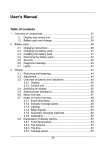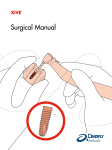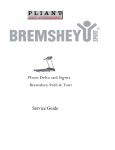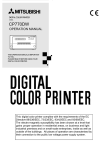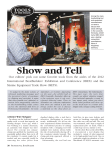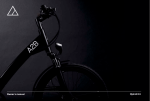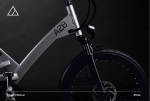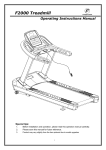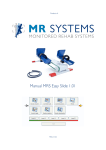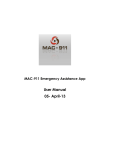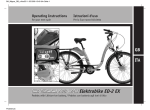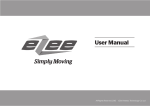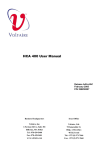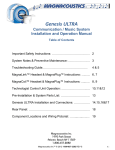Download User`s Manual
Transcript
User's Manual Table of contents 1 Overview of components...................................................................................51 1.1 1.2 2 Display and control unit......................................................................51 Battery pack and charger.................................................................. 52 Battery pack..................................................................................................... 53 2.1 Charging instructions......................................................................... 53 2.2 Charging the battery pack................................................................. 55 2.3 Installing the battery pack.................................................................. 56 2.4 Removing the battery pack ............................................................... 56 2.5Security.............................................................................................. 57 2.6 Diagnosis message........................................................................... 57 3 Display ION...................................................................................................... 58 3.1 Removing and fixing.......................................................................... 58 3.2Adjustment......................................................................................... 58 3.3 Overview of buttons and indications.................................................. 59 3.3.1Display.................................................................................... 59 3.3.2 Control unit............................................................................. 59 3.4 Switching on and off the system........................................................ 59 3.5 Setting power assistance................................................................... 60 3.6 Display options................................................................................... 60 3.6.1Temperature........................................................................... 60 3.6.2 Trip distance........................................................................... 61 3.6.3 Trip time.................................................................................. 61 3.6.4 Average speed....................................................................... 61 3.6.5 Maximum speed..................................................................... 62 3.6.6 Total distance......................................................................... 62 3.6.7Range..................................................................................... 62 3.6.8 Trip information....................................................................... 63 3.7 Menu overview................................................................................... 64 3.8 Notes on menu overview................................................................... 65 3.8.1 Time and language................................................................. 65 3.8.2Brightness.............................................................................. 65 3.8.3View........................................................................................ 66 3.8.4 Trip counter............................................................................ 67 3.8.5Sound..................................................................................... 67 3.8.6Lighting................................................................................... 68 3.8.7 Automatic charging................................................................ 69 3.8.8Calibrating.............................................................................. 70 49 4 Display brandspecific....................................................................................... 71 4.1 Removing and fixing.......................................................................... 71 4.2Adjust................................................................................................. 71 4.3 Overview of buttons and indications.................................................. 72 4.3.1Display.................................................................................... 72 4.3.2 Control unit............................................................................. 72 4.4 Switching on the display.................................................................... 72 4.5 Set the support................................................................................... 73 4.6 Menu overview....................................................................................74 4.7 Menu setting explanation................................................................... 75 4.7.1 Extra information.................................................................... 75 4.7.2 Indicator Average speed........................................................ 76 4.7.3Lighting................................................................................... 77 4.7.4 Beep Signals.......................................................................... 77 4.7.5 Automatic Charging................................................................ 77 4.7.6Calibration.............................................................................. 79 4.8 View options....................................................................................... 80 4.8.1 Time / Temperature................................................................ 80 4.8.2 Trip distance........................................................................... 80 4.8.3 Trip time.................................................................................. 80 4.8.4 Average speed....................................................................... 80 4.8.5 Maximum speed..................................................................... 81 4.8.6 Total distance......................................................................... 81 4.8.7Range..................................................................................... 81 4.8.8 Trip 1 and Trip 2...................................................................... 81 5 Range indication table...................................................................................... 83 6Throttle............................................................................................................. 85 6.1Throttle............................................................................................... 85 6.2 Boost function.................................................................................... 85 6.3 Parking assistance ............................................................................ 85 7 Technical data.................................................................................................. 87 7.1 7.2 7.3 8 Weight and performance................................................................... 87 Temperature limits for battery cells.................................................... 87 Charger data...................................................................................... 87 Diagnosis messages........................................................................................ 88 8.1 Indication on the display ................................................................... 88 8.2Service............................................................................................... 90 8.3 Use of other displays......................................................................... 91 8.4 Speed sensor..................................................................................... 91 9 Warranty conditions and legal requirements................................................... 92 50 1 Overview of components 1.1 Display and control unit Display brand specific Display ION A A C B M C A D isplay B D isplay holder C Control unit 51 B 1.2 Battery pack and charger D F A B I C J H E F G A B C D E B attery pack State of charge display Charging point Docking station Docking station contact point F G H I J 52 Lock Key Plug Charger Indicator 2 Battery pack 2.1 Charging instructions Read the following instructions and warnings carefully before using the e-bike. The manufacturer is not responsible for accidents or malfunctions caused by improper use of the e-bike or parts of the e-bike: • Fully charge the battery pack once before the first use of the bike. • Every battery runs down over time. This process is called ‘self-discharge’. A battery pack that is empty and that is not charged can reach deep discharge due to self-discharge within two months, causing it to become defective. The warranty is void in the event of deep discharge. • The battery pack does not need to be completely empty before charging. The battery pack will remain in good condition if you charge the bicycle after every use (regardless of the trip distance). Once the battery is fully charged, charging stops automatically. The light on the charger continues to be lit green. • You can leave the charger connected for long-term storage. If this is not possible, charge the battery pack fully and disconnect the charger from the battery pack. Charge the battery pack fully at least once every two months. • Ensure that the battery pack remains within the temperature limits given below. This extends the lifespan and increases the performance of the battery pack. Furthermore, charging or the power assistance will not work outside the temperature limits. Status Minimum [°C] Maximum [°C] 0 45 During use -15 60 Storage (at least 80% charge level) -10 35 While charging 53 • A lways charge the battery pack using the charger delivered with the bicycle. Do not use any other charger. The colour of the plug must match the colour of the socket. • N o not connect the charger to the mains voltage when it is not used. • Disconnect the charger from the battery before you start cycling. • M ake sure that the charger does not get wet. • D o not damage the charger. • D o not charge the battery pack in direct sunlight. • D o not drop the battery pack. This can damage the battery pack. • R emember that your bike produces less power assistance at lower temperatures (below 10°C) and that the battery pack will run empty more quickly. • Large temperature changes can cause major differences in the battery charge indication, especially at low temperatures and with a low charge on the battery pack. 54 2.2 Charging the battery pack 1. Check whether the mains cord has been connected to the charger correctly (A). 2. Connect the charger (A) to the mains voltage. The green indicator lamp (B) will light up. 3. Connect the plug (C) to the charger at the charging point (D). 4. An LED light (E) on the battery pack will start to flash. 5. When all 5 LED lights (E) are lit, the battery pack is fully charged. E A B D C C D The battery can be charged both on and separate from the bicycle. If the battery is charged on the bike, the battery charge of the battery pack will be displayed on the display in percentages. An indication of the expected charging time will also be displayed. The actual charging time can vary and will depend on the temperature, charger type and battery type. If the battery is charged separate from the bike, the LED lights on the battery pack will display the battery charge. Every LED light represents 20%. Also see the table below. Number of lit LED lights on the battery pack while charging Charge indication 4 (5th flashes) 80 - 100 % 3 (4th flashes) 60 - 80 % 2 (3rd flashes) 40 - 60 % 1 (2nd flashes) 20 - 40 % None (1st flashes) 0 - 20 % * Example (charging separate from the bike): 1 LED on the battery pack lights up green and the 2nd LED flashes: the charging process has now charged the battery between 20% and 40%. *Pedal assist will stop with 0% battery charge. The battery pack will still have enough energy to supply power to the display and bicycle lights for a few hours (also see par. 3.8.6). 55 2.3 Installing the battery pack A 1. Remove the key from the lock of the docking station (A). 2. Carefully push the battery pack (B) under the luggage carrier alongside the guide until the lock clicks (C). 3. Make sure that the cover (D) of the charging plug is closed. B C D 4. Make sure the battery pack (B) is locked by pulling it backwards. A correctly installed battery pack can no longer be removed without a key. 2.4 B B Removing the battery pack 1. Insert the key (A) in the lock (B) (this key is the same as the key for the bicycle lock). 2. Make sure that the cover (C) of the charging plug is closed. A C 56 3. Remove the battery pack (A) from the luggage carrier using the handle (B) on the bottom of the battery pack. • • 2.5 B A Always remove the battery pack with two hands to prevent the battery pack from falling. Take the battery pack out of the luggage carrier when transporting the bicycle by car. Security The battery pack can only be used on the bicycle on which it has been installed. A code in the software makes sure that it cannot be used on another bicycle, that is to say, there will be no peddling assistance (protection against theft). A second battery pack can in many cases be purchased for your e-bike. Contact your dealer for more information. 2.6 Diagnosis message If all the LED lights on the battery pack flash, first check whether the battery pack (A) has been connected correctly to the contact point of the docking station (B). If the LED lights continue to flash, contact your dealer. A B LED The contact surface between the battery pack and the docking station must be free from dirt and moisture to make sure the e-bike works correctly. Use a clean cloth to clean it if required. Much moisture and dirt can lead to contact problems and/or faults. 57 3 Display ION This chapter gives information about the display with ION on it. Chapter 4 is about the brand specific display. That probably is Batavus, Ghost, Hercules, Koga or Sparta. 3.1 Removing and fixing Removing: Press the button (A) on the rear side and pull up the display (B) from the display holder (C) as shown in the adjacent figure (left arrow). Tightening: Position the bottom side of the display (B) in the display holder (C) and, next, press the display down so that the display holder clicks as shown in the adjacent figure (right arrow). B A C The contact surface between the display and the display holder must be free from dirt and moisture to make sure the e-bike works correctly. Use a clean cloth to clean it if required. 3.2 Adjustment B Slightly loosen the 2 screws (D). Hold on to both the display (B) and the display holder (C) to turn them both. The display does not need to be removed. Remove the display when storing and transporting the bike. 58 C D D 3.3 Overview of buttons and indications C D 3.3.1 Display ASpeed B Time (par. 3.8.1) C Lights (par. 3.8.6) D Frost symbol (par. 3.6.1) E Battery charge (par. 2.2) F Variable display option (par. 3.6) G Assistance level (par. 3.5) B 0 A Temperature XX°C km/h .0 H K On/off button Arrow to the right* Arrow to the left* Arrow up* Arrow down* G 0 3.3.2 Control unit H I J K L E F 0% 00:00 I L J * Driving position operation and display options. - The buttons of the control unit are lit when the system is on. This is not linked to the bike lights. - The control unit can be installed either on the left or right. 3.4 Switching on and off the system 0:00 0 The system can be switched on by pressing the for a short period of time. Pedal assist will be switched of by pressing the for a short period of time. If the is pressed for 2 seconds, the entire system will switch off: the pedal support, lights and display will no longer be operational. When the e-bike is not being used, the system and lights will switch off automatically after five minutes. 59 km/h .0 0% 0 3.5 Setting power assistance Switch on the system by pressing the . Press the or to set the assistance (G). The assistance settings are: 1. ECO 2. CRUISE 3. TOUR 4. SPORT 5. POWER 0% 0:00 0 CRUISE km/h .0 2 You can alternate between the positions with the and . If you alternate between the assistance positions while cycling, this option will be displayed at the top on the right for a short period of time. 3.6 Display options You can choose whether you want a simple or extensive information to be displayed on your display. See below at par. § 3.8.3. If you select Simple, you will not be shown additional information. If you select Extensive, you will be shown different display options on your display. All possible options are explained briefly below. The time is always displayed on the display. If the basic display is shown, you can navigate through the display options by using the and . 3.6.1 Temperature You can select this to show the outside temperature on your display. The Temperature option is the first function. 60 0% 0:00 0 Temperature 23°C km/h .0 0 G The display will show a frost symbol (D) when the outside temperature is 4°C or lower. When this symbol is shown on the display, the road surface may be slippery. Adjust your speed to this. The range of the battery pack will decrease considerably when the ambient temperature is this low. The frost symbol can be found at the top on the left. 3.6.2 Trip distance D 0% 0:00 0 Temperature 4°C km/h .0 0% 0:00 The Trip distance indicates how far you have cycled with your e-bike during the current trip. The trip distance is measured from the moment that you start cycling. To reset the Trip distance see par. 3.6.8. 3.6.3 Trip time 0 Trip distance 0.0 km km/h .0 0:00 The Trip time indicates how long you have used your e-bike during the current trip. The trip time is measured from the moment that you start cycling. To reset the Trip time see par. 3.6.8. 3.6.4 Average speed 0 km/h .0 0:00 0 The average speed over the cycled distance is displayed at Avg. speed. To reset the Average speed see par. 3.6.8. km/h .0 61 0 0 0% Trip time 0:00 0 0% Avg. speed 0.0 km/h 0 3.6.5 Maximum speed 0% 0:00 The maximum speed with regard to the current trip is displayed at Max. speed. To reset the Max. speed see par. 3.6.8. 0 Max. speed 0.0 km/h km/h .0 0 3.6.6 Total distance The total number of cycled kilometers is shown at Total distance measured as from when you start using the bike. You cannot reset the Total distance. 0% 0:00 0 Total distance 0 km km/h .0 0 3.6.7 Range The range shows how many kilometers can still be cycled with assistance. This depends on the assistance setting. The lower the setting, the higher the range. At range 0, a range will not be shown because the range without assistance is limitless. If a range is displayed on your display, you can see what the difference is in range per assistance setting with the and . 0:00 0 km/h .0 0% Range --- km 0 The range is calculated based on current and historic use in combination with the battery charge of the battery pack. The temperature also plays a role in this calculation. 62 If the battery pack is basically fully discharged, the "Limited support" message will be displayed on the display. If the battery pack is discharged, the bike cannot offer assistance. Charge the e-bike as soon as possible so that you can always use assistance. A battery pack that is fully discharged and is not charged, may overdischarge. See par. 2.1. 0:00 0 0% Limited support km/h .0 For more information about range figures, see chapter 5. 3.6.8 Trip information The trip distance and time and the average 0:00 0% and maximum speed are linked to each Trip time other. 0:00 The trip counter (see par. 3.8.4) will keep km/h 0 track of the information of the current trip, for example, the trip distance (see par. 3.6.2) and trip time (see par. 3.6.3.). You can select an automatic or manual reset. If you select Automatic reset, the trip counter will be reset automatically when the bike is not used for longer than 2 hours. If you select Manual reset, make sure that the "trip distance" or "trip time" option is displayed on the display. Next, hold the pressed for 3 seconds. The trip counter will now be reset to 0. 0 .0 63 3.7 Menu Menu overview Settings Time hh:mm Language Nederlands see §3.8.1 2 sec. Back 1sec English see §3.8.1 Deutsch Francais Screen Brightness View Controlunit Functions Trip counter Sound Lighting Automatic charging Maintenance Calibration * 0-100 see §3.8.2 Simple see §3.8.3 Advanced see §3.8.3 Automatic reset see §3.8.4 Manual reset see §3.8.4 Always on see §3.8.5 On alerts see §3.8.5 Off see §3.8.5 Always on see §3.8.6 Automatic see §3.8.6 Off see §3.8.7 Automatic see §3.8.7 * see §3.8.8 see §3.8.9 Service info View-options Temperature see §3.6.1 Trip distance see §3.6.2 Trip time see §3.6.3 Avg. speed see §3.6.4 Max. speed see §3.6.5 Total distance see §3.6.6 Range see §3.6.7 Trip information see §3.6.8 *Automatic charging and calibration is not available on every e-bike. See §3.8.7 and §3.8.8. 64 3.8 Menu overview explanation 3.8.1 Time and language You can open the menu overview by pressing the for 3 seconds. You can navigate through the menu by using the , , and . The menu structure and also which buttons must be used on the control menu are explained in § 3.7. Time The time is always displayed on the display. The time can be adjusted by selecting the Time option on the Settings menu. You can open a display where the time is shown by again pressing the . Use the , , and to adjust the time. Use the to confirm the set time. You can return to the basic display by pressing a few times. SETTINGS Time Language Language SETTINGS The language can be set by selecting the Time Language option on the Settings menu. Language If you want to change the language, press the . Use the and to toggle between the available languages. When you have selected the required language, again press the . You can return to the basic display by pressing a few times. You can select between Dutch, English, German and French. 3.8.2 Brightness (optional) The display's brightness will automatically be different when it is dark outside when compared to the daylight display. You can set this brightness. This, however, can only be set if the display is really in the "night setting", therefore, in a dark environment. The display's brightness during daylight is a fixed value and cannot be set. 65 - Hold the pressed for 3 seconds. - Use the and to go to the Screen menu. - Use the to go right. - Use the ( and) to go to Brightness. - Press the once. - Select the required option using and . - Again press the to set the required option. - Press the several times to return to the basic display. 3.8.3 View You can select between a simple or extensive display to be shown on the display. If you select Simple, additional information will not be shown on the display. If you select Extensive, additional information will be shown on the display. The options have already been explained above: - Temperature (par. 3.6.1) - Trip distance (par. 3.6.2) - Trip time (par. 3.6.3) SCREEN - Average speed (par. 3.6.4) Brightness - Max. speed (par. 3.6.5) View - Total distance (par. 3.6.6) - Range (par. 3.6.7) After the range, an option is shown that no additional information is shown on the display. You can alternate between the different options with the and . - Hold the pressed for 3 seconds. - Use the and to go to the Screen menu. - Use the to go right. - Use the ( and) to go to View. - Press the once. - Select the required option using and . - Again press the to set the required option. - Press the several times to return to the basic display. 66 3.8.4 Trip counter 0:00 0 0% The trip counter will keep track of the Trip time information of the current trip, for example, 0:00 the trip distance (see § 3.6.2) and trip time km/h (see § 3.6.3.). You can select an automatic 0 or manual reset. If you select Automatic reset, the trip counter will be reset automatically when the bike is not used for longer than 2 hours. If you select Manual reset, make sure that the "trip distance" or "trip time" option is displayed on the display. Next, hold the pressed for 3 seconds. The trip counter will now be reset to 0. .0 - Hold the pressed for 3 seconds. - Use the and to go to the Functions menu. - Use the to go to Trip counter. - Again press the . - Select the required option using the and . - Again press the to set the required option. - Press the several times to return to the basic display. FUNCTIONS Trip counter Sound Lighting Automatic charging 3.8.5 Sound You can set whether (and in which cases) you want to hear sound under Sound. If you select Always on, the display will emit five long beeps when there is a message. In addition, you will hear a short beep when you press the buttons of the control unit, after calibrating and after resetting a trip. If you select When warnings occur, the display will emit five long beeps when there is a message. Your display will not emit a beep if you press the buttons of the control unit, after calibrating and after resetting a trip. If you select Off, the display will not emit any beeps. 67 - Hold the pressed for 3 seconds. - Use the and to go to the Functions FUNCTIONS menu. Trip counter - Use the to go right. Sound - Use the ( and) to go to Sound. Lighting - Again press the . Automatic charging - Select the required option using and . - Again press the to set the required option. - Press the several times to return to the basic display. 3.8.6 Lighting You can set whether you always want the lights to be on or that they go on FUNCTIONS automatically under Lights. Trip counter If you select Always on, the bike's lights Sound will always be on. Lighting If you select Automatic, the bike's lights Automatic charging will be switched on and off automatically. The light sensor continuously measures the quantity of light and will switch the lights on and off based on this information. The lights (both at the front and rear) are supplied with power from the battery pack and will, therefore, only work when the battery pack has been installed in the e-bike. The motor will work as a dynamo when the battery pack is fully discharged*. The rear light is fixed to the battery pack. If you need to replace the rear light, we recommend contacting your certified e-bike dealer. - Hold the pressed for 3 seconds. - Use the and to go to the Functions menu. - Use the to go right. - Use the ( and) to go to Lights. - Again press the . - Select the required option using and . *Works only on e-bikes with a front- or rear wheel motor. Middle motor: p.43. 68 - Again press the to set the required option. - Press the several times to return to the basic display. 3.8.7 Automatic charging The 'automatic charging' function only works on e-bikes with a rear wheel motor. The e-bike will automatically generate energy when pressure is not applied to the pedals. This makes sure that the battery pack can be charged while cycling. To use this function, you must first switch it on in the menu. The automatic charging function works up to about 35 km/h and approximately 80% of the battery charge depending on the temperature. Switching on automatic charging The selected many setting will be active immediately and will continue to apply until it is again adjusted on the display menu. If the automatic charging function has been activated and no pressure is applied to the pedals, the battery pack will be charged automatically. You will feel a slight resistance on the motor while charging and the "Charging" text will be displayed on the display. - Hold the pressed for 3 seconds. FUNCTIONS - Use the and to go to the Functions menu. Trip counter - Use the to go right. Sound - Use the ( and) to go to Automatic Lighting Automatic charging charging. - Again press the . - Select the required option using and . - Again press the to set the required option. - Press the several times to return to the basic display. 69 3.8.8 Calibration The 'calibrate' function is only displayed on e-bikes with a front- or rear wheel motor. MAINTENANCE Calibration If the assistance reduces after a time, the Service info electronics may have to be calibrated. 1. Position yourself next to the bike. 2. Do not apply pressure on the pedals. 3. Hold the pressed for 3 seconds. 4. Use the to go to the Maintenance menu. 5. Use the to select Calibration. 6. Again press the . 7. Calibration will now be performed. 8. Press the several times to return to the basic display. To keep a pleasant assistance, we recommend calibrating the e-bike once a month. 70 4 Display brand specific This chapter is about the brand specific display. That brand is probably Batavus, Ghost, Hercules, Koga or Sparta. Chapter 3 is about the display with ION on it. 4.1 Removing and fixing Removing: Press the button (A) on the bottom side and remove the display (B) from the display holder (C). B A Fixing in place: Position the display (B) obliquely on the display holder (C) and click it in place in the lock. C 4.2 Adjust Loosen the handles (A) and twist the display holder. Remove the display when storing and transporting the bicycle. To ensure that the E-bike works correctly, make sure the interface between the display and the display holder is free of dirt and moisture. If necessary, clean it with a clean, dry cloth. 71 A 4.3 Overview of buttons and indications 4.3.1 Display A A Present speed B Peddling assistance level C Battery pack charge level D Lighting indicator E Variable indicator F Variable indictor description GTemperature/Time H View Trip 1/Trip 2 I Average speed indicator J Frost symbol C D J I H G 50% 18 . 0 B 1 km/h 2 F E xxxxxxxxxxxxx 21 ° C 13.82km 4.3.2 Control unit K L M N O Lighting button Up button – variable application Set – variable application Down button – variable application Mode button – variable application 4.4 K L M N O Switching on the display If the up arrow on the lighting button is pressed, the reading will be displayed. When the E-bike is not in use, the power assistance and lighting will switch off automatically after five minutes. Fifteen minutes later, the display will automatically switch to sleep mode and no longer show an image. To get the display out of sleep mode, press on or or put the E-bike into motion. 72 90% 0.0 km / h 21 ° C 0.00km 4.5 Set the support Press the up (L) or down (N) button to set the support (B). L Ride programme: 1. ECO 2. CRUISE 3. TOUR 4. SPORT 5. POWER B 100% 0.0 1 km/h 21°C N 73 0 . 0 0 km 4.6 Menu overview Settings General Time 24hours/12hours Contrast ..(set: -10 - +10) Backlight ..(set:10-100) 3sec hh:mm (set) Back 1sec View Language English Nederlands Controlunit Deutsch Francais Distance Kilometers Temperature Celcius Miles Fahrenheit Extra info Time Temperature see §4.7.1 Off Avg. speed Indicator off see §4.7.2 Indicator on Functions Lighting Auto see §4.7.3 Manual Beeper On On alerts see §4.7.4 Off Auto charge Off Manual see §4.7.5 Auto Maintenance View options Calibration see §4.7.6 Service info 1sec Trip1/Trip2 view see §4.8.8 1sec Reset Trip Trip 1 will aso be automatically reset after 2 hours of inactivity. 2sec 74 Temperature/Time see §4.8.1 Trip distance see §4.8.2 Trip time see §4.8.3 Average speed see §4.8.4 Maximum speed see §4.8.5 Total distance see §4.8.6 Range see §4.8.7 4.7 Menu setting explanation 4.7.1 Extra information With this option you can indicate whether you want to see extra information in the display. The chosen option is shown as a standard at the bottom left of the display. If you select Time, the time will be displayed on the left at the bottom of the display as standard. Temperature is then shown under display options. 100% 20.0 3 k m/h 14. 14 100% 20.0 3 k m/h If you select Temperature, the temperature will be displayed on the left at the bottom of the display as standard. Time is then shown under display options. The display will show a frost symbol when the outside temperature is 4°C or lower. When this symbol is shown on the display, the road surface may be slippery. Adjust your speed to this. The range of the battery pack can decrease considerably when the ambient temperature is this low. When you select Off, the room at the bottom left of the display remains empty. Both Time and Temperature will then be shown under display options. 75 8°C 100% 0.0 k m/h 4°C 0.00km 100% 20.0 3 k m/h 4.7.2 Indicator Average speed The indicator for average speed indicates, when cycling, whether the current speed is above or below the average speed of the ride. Arrow upwards means: current speed is above the average speed of the ride. 100% 20.0 k m/h 1 Av erage s peed 14.12 18.0km/h Arrow downwards means: current speed is below the average speed of the ride. 100% 17.0 k m/h 1 Av erage s peed 14.12 18.0km/h Block means: current speed is almost the same as the average speed of the ride. 100% 18.0 k m/h 1 Tri p di s t anc e 14.12 0.22km With the option Average Speed you indicate whether you want to show the indicator in the display or not. 76 4.7.3 Lighting You can set whether you wish the lights to be switched on automatically or whether you wish to do this manually under Lighting. If you select Auto, the bicycle lighting will be switched on and off automatically. A light sensor will continuously measure the quantity of light and will switch the lights on and off based on this. If you select Manual, the bicycle lighting will only be switched on or off when you use the lights button on the control unit. 4.7.4 Beep Signals You can set whether and when you wish to hear beep signals under Beepers. If you select On, the display will emit five long beeps when there is a message on the display. In addition, you will also hear a short beep signal when you press the control unit buttons, after calibrating and after resetting a ride. If you select On alerts, the display will emit five long beep signals when there is a message. Your display will not emit beep signals with this setting when the control unit buttons are pressed, after calibrating and after resetting a ride. If you select Off, the display will not issue beep signals when operating the control unit nor when there are alerts, after calibrating and after resetting a ride. 4.7.5 Automatic Charging With this function, the E-bike automatically generates energy when no pressure is being exerted on the pedals. This allows the battery pack to recharge while you are cycling. To use the function, you first have to switch it on via the display menu. You can then use the set button to activate or deactivate automatic charging. Automatic charging works up to about 80% capacity and up to about 35 km/h. 77 Turning on automatic charging You can turn on automatic charging by selecting (in this order) Functions, Auto Charge and Manual or Automatic in the display menu. The selected menu setting will apply until you change it again in the display menu. AUTO CHARGE O ff Manual Auto NB: When you turn on automatic charging, the set button toggle function between Trip 1 and Trip 2 (see 4.8.8). loses its Activating automatic charging Manual If you select the Manual option via the display menu, automatic charging will be inactive when you turn on the E-bike. You can activate the automatic charging, when pedal assistance is engaged, by pressing briefly on the set button . The message "Auto Charge on" will appear temporarily. The function will then remain active until the E-bike is switched off (and the brand logo disappears). If you want to deactivate automatic charging during the journey, press the set button briefly again. The message "Auto Charge off" will then appear temporarily. Automatic If you select the Automatic option via the display menu, automatic charging will be active as soon as you engage the pedal assistance. If you want to deactivate automatic charging during the journey, press the set button briefly. The message "Auto Charge off" will then appear temporarily. 78 50% 50% 20 . 0 km/ h 1 20.0 km/h 1 A ut o char ge on 14:22 2 0 . 0 km / h Auto c harge off 14:22 2 0 . 0k m / h When automatic charging is activated and no pressure is being exerted on the pedals, the battery pack will be recharged automatically. When charging takes place, you will feel a slight resistance against the motor. The message "Charging…" and a plus-sign or two arrows will appear in the battery icon (depending on the type of display). 51% 51% 20 . 0 km /h 1 1 6 :11 20 . 0 km/h 1 Charging... 2 0 .0 k m /h 14: 35 Charging... 20. 0 k m/h 4.7.6 Calibration If the peddling assistance is reduced in K due course, the electronics may have to be calibrated. 1. Stand next to the bicycle. Do not exert force on the pedals. 2. Switch off the lights (K). 3. Keep the lights button pressed for at least two seconds until the message is issued that the calibration has been completed. For continued comfortable pedal assistance,we advise you to calibrate the E-bike once per month. 79 4.8 View options By briefly pressing the MODE button, you decide what you want to show at the bottom right of the display. All possible display options are briefly explained below. 4.8.1 Time / Temperature With menu settings you can select whether want to see Time, Temperature or nothing as a standard at the bottom left of the display (see § 4.7.1). The non-selected option(s) will then be placed automatically under display options. 4.8.2 Trip distance 100% 20.0 3 k m/h The trip distance measured from the moment that you start cycling. For resetting the “Trip distance” see § 4.8.8. Tri p di s t anc e 23 ° C 0.35km 4.8.3 Trip time 100% The trip time measured from the moment that you start cycling. For resetting the “Trip time” see § 4.8.8. 20.0 k m/h 14.14 Tri p t i m e 00:13 4.8.4 Average speed Average speed measured over the cycled distance. For resetting the “Average speed” in § 4.8.8. 80 100% 20.0 k m/h Av er age s peed 14.12 2 5 . 0 km/ h 4.8.5 Maximum speed Maximum speed measured over the cycled distance. For resetting the “Maximum speed” see in 4.8.8. 100% 20.0 k m/h M ax i m um s peed 14.13 25.9km/h 4.8.6 Total distance Total distance measured from the moment that you start cycling. It is not possible to reset the total distance. 100% 20.0 3 k m/h Tot al di s t anc e 23 ° C 30km 4.8.7 Range The range shows how many kilometres you can still cycle using peddling assistance. The range is calculated on the basis of actual and historic consumption in combination with the charging level of the battery pack. 100% 20.0 3 k m/h 14.13 R ange 3 9 km 4.8.8 Trip 1 and Trip 2 The Trip distance, Trip time, Average speed and Maximum speed are linked to each other and are kept track of twice, that is, in Trip 1 and Trip 2. You can select between the view of Trip 1 and Trip 2 on the display by pressing theset button briefly. Resetting Trip 1 will be automatic when the bicycle is not used for more than 81 100% 20.0 k m/h 2 Tr ip dis t anc e 16:30 0 . 0 5 km 2 hours. Trip 1 can also be reset manually by keeping the set button pressed for a long time. You can only reset Trip 2 manually by keeping the set button pressed for a long time. 82 5 Range indication table D-Light front wheel motor (25 Nm) Eco (km) Cruise (km) Tour (km) Sport (km) Power (km) Battery pack min max min max min max min max min max 317 Wh 50 110 35 75 25 60 15 40 15 30 418 Wh 65 145 45 100 35 75 25 50 20 45 522 Wh 85 185 60 125 45 95 30 65 25 55 612 Wh 100 215 70 150 50 115 35 75 30 65 XHPL rear wheel motor (40 Nm) Eco (km) Cruise (km) Tour (km) Sport (km) Power (km) Battery pack min max min max min max min max min max 317 Wh 70 135 50 100 35 70 30 55 25 50 418 Wh 90 175 70 130 45 90 40 75 35 70 522 Wh 115 220 85 165 60 115 50 95 45 85 612 Wh 135 260 100 195 70 135 60 110 50 100 XHP rear wheel motor (50 Nm) Eco (km) Cruise (km) Tour (km) Sport (km) Power (km) Battery pack min max min max min max min max min max 317 Wh 70 135 50 100 35 70 30 55 25 50 418 Wh 90 175 70 130 50 95 40 75 35 70 522 Wh 115 220 85 165 60 120 50 95 45 90 612 Wh 135 260 100 195 75 140 60 110 55 105 83 Middle motor (80 Nm) * Eco (km) Cruise (km) Tour (km) Sport (km) Power (km) max min max min max min max min max 55 120 35 75 30 70 25 60 20 50 418 Wh 70 160 45 100 40 90 35 80 30 70 522 Wh 90 200 60 125 50 115 45 100 40 85 612 Wh 105 230 70 150 60 135 55 115 45 100 Battery pack min 317 Wh Double E / Double i (tandem) (30 Nm) Eco (km) Cruise (km) Tour (km) Sport (km) Power (km) max min max min max min max min max 40 60 35 60 30 50 25 50 15 35 418 Wh 55 80 45 75 40 70 35 65 25 45 522 Wh 70 100 60 95 50 85 45 80 30 60 612 Wh 85 120 70 115 60 105 50 95 35 70 Battery pack min 317 Wh The range depends on various factors and is influenced by the following: • Capacity (Ah) and voltage (V) of the battery pack; • Pedal assistance level; • Pedal assistance mode or riding program, ask your dealer about the possibilities; • Ambient temperature; • Wind force; • Tyre pressure (at least 4 bar); • Cycling speed; • Weight of the cyclist and the load; • Cycling behaviour; • Road conditions; • Use of gears. The range will perceptibly decrease as the battery pack gets older. Also see par, 3.6.7 for the specification of the range on the display. *These range numbers apply to e-bikes provided with the riding program as installed in the factory. 84 6 Throttle 6.1 Throttle The throttle (B) can be used as soon as the assistance has been switched on. You can accelerate by turning the A B throttle toward you. When using it for the first time, try the throttle carefully so as to become familiar with the power generated by the throttle. 1 2 3 6 7 8 4 5 A Control unit BThrottle The control unit and throttle can be installed both on the left or right. They will work in the same way on either side. 6.2 Boost function The boost function can be used as soon as the e-bike has been switched on*. By turning the throttle toward you in the 1, 2, 3, 4 or 5 position, you will get a boost. This will fill as a "push in the back". When using it for the first time, try the boost function carefully so as to become familiar with the power generated by the boost function. The boost function is linked to the assistance levels. The effect of the throttle can be strongly felt in the ECO position while it is felt the least in the POWER position. Using the boost function at low speeds costs a lot of energy. This will influence the e-bike's range. Extra assistance when riding from a standstill You can use the boost function when riding from a standstill. Parking assistance will provide assistance, without pedaling, up to 3 km/hour. After that, you must pedal yourself to get assistance. Extra assistance while cycling The boost function can provide an extra impulse while cycling. This is handy when overtaking someone, or cycling up a hill. 85 6.3 Parking assistance The throttle assists up to approximately 3 km/hour when you are walking alongside the bike. Useful when you take the e-bike from your shed or basement so that you do not have to push the e-bike all by yourself. Display brandspecific The parking assistance can be used as soon as you put the e-bike in position P. This position can be reached in the same way as you change your position (up and down button). Before the first position you'll find position 0 (off) and before that you'll find position P. Display ION The parking assistance can be used as soon as the e-bike has been switched on*. By turning the throttle toward you in the 1, 2, 3, 4 or 5 position, you will get a boost and you can use the parking assistance. The speed and power of the boost will depend on the selected gear. A higher gear will deliver less power and more speed. The speed will always be lower than the legal speed limit. * When you start cycling, the assistance is at 0 and the boost function/ parking assistance will not operate. To make use of the boost function/ parking assistance, the assistance must first be switched on by pressing + or -, so that it is set at 1, 2, 3, 4 or 5. 86 7 Technical data 7.1 Weight and performance 300 Wh series 400 Wh series 500 Wh series 600 Wh series Capacity (Ah) 8.8 11.6 14.5 17 3 3 3.5 3.5 Maximum power (W) 250 250 250 250 Charging time 80% (hrs) 3.5 5 6 6.5 Charging time 100% (hrs) 4.5 6 7.5 8.5 Voltage (V) 36V 36V 36V 36V Energy (Wh) 317 418 522 612 Weight of battery pack (kg) 7.2 Temperature limits for battery cells Status Minimum [°C] Maximum [°C] 0 45 -15 60 While charging During use 7.3 Charger data Input voltage 100-240 Vac (50-60Hz) Input power Max. 150 W Input current Max. 1,5 A 87 8 Diagnosis messages 8.1 Indication on the display Contact your dealer shop if the message is not listed in the manual. E10 FAILURE Contact dealer Do not remove the rear wheel. This may affect the performance of the bicycle. Message E01 Diagnosis Solution Battery pack flat Charge the battery pack. E05 Bad motor connection Switch on the pedal assistance and check if the battery pack is placed correctly. E06 Short circuit in lighting Please contact your dealer. E07 Motor outside temperature range The motor is loaded to heavily. Allow it to cool down so that you can continue cycling. E14 Display is not recognised The display needs resetting. Take your bicycle to the dealer. E16 Constant activity of the power sensor Calibrate by holding the light button pressed for 5 seconds. 88 Message Diagnosis Solution E19 Battery pack outside the temperature range Wait until the battery pack is within the temperature range. The charging will then automatically continue. E20 Service needed Contact your dealer for the planned maintenance service. E21 Motor current regulator The assistance is adjusted by heavy use. E22 Problems while charging Turn the lights on/off and wait for 10 seconds. Reconnect the battery charger. Go to the dealer if the message reappears. E23 Serial number motor incorrect This battery pack has not been installed on the bicycle. If this is not the case, please contact your dealer. E30 Turn on the pedal assistance No communication with and check if the battery pack torque sensor is placed correctly. E32 Battery electronics are too warm. Let the battery pack cool down and switch on the pedal assistance again. E34 Control unit does not support accessories Please contact your dealer. E35 Check whether the plug of No communication with the throttle is placed well in throttle the control unit and place the display again. E39 Wrong charger connected Connect the correct charger. 89 Message Diagnosis Solution E45 Max temperature of motor controller reached E55 Unknown serial number of the motor or error in Please contact your dealer. motor communication E56 'Check speed sensor' E58 8.2 Allow the motor controller to cool before switching on support again. Problem with speed sensor Check the speed sensor and magnet in the rear wheel, also see §7.4. Problem not solved? Then contact your dealer. Problem with speed measurement Check that the speed sensor is correctly connected. Service 0% 0:00 The Maintenance advised message may be displayed on the display after a specific distance. This message will be displayed when starting the system and briefly during cycling. Your dealer can set the distance after which this message should be displayed. You can see which distance you still need to cover until the next service in the Maintenance menu. When this message is displayed, we recommend contacting your dealer. 0 Maintenance advised km/h .0 SERVICE INFO Distance to next maintenance: .. km 90 8.3 Use of other displays 0% The display acts as an immobilizer and, therefore, you cannot install of fully use every display on your e-bike. A unique code has been saved on your display that matches the related e-bike. If you want to switch on the assistance or lights, the system will check whether the display and the bike form a unit. If this is not the case, error message E14 will be displayed and the assistance and lights cannot be switched on. If you have two e-bikes with the same display type, you can register both displays on both bikes. Your certified e-bike dealer can perform this for you. Both displays will then work on both bikes. 8.4 E-0014 E14 FAILURE Unknown display Speed sensor Your e-bike's system needs information to function properly. The speed information is obtained by the rear wheel sensor (behind the chain casing) and a magnet in the wheel. Sometimes the magnet becomes dislodged, for instance when cleaning the m m 10 max. e-bike or when loading/unloading the e-bike on the bicycle carrier. If the magnet becomes dislodged, then the speed can no longer be measured. Your display will indicate 'Check speed sensor'. In this case you can still cycle home safely, or take your e-bike to the dealer, but only with limited speed and assistance. The problem can be solved by returning the magnet to the correct position, see the figure below. The 'Check speed sensor' indication will then automatically disappear. If you have returned the magnet to the correct position, but the 'Check speed sensor' indication remains, then contact your dealer. 91 9 Warranty conditions and legal requirements Guarantee conditions The following guarantee conditions supplement the applicable legal rights. When does the guarantee apply? The supplier of the battery pack will give a guarantee for any material or construction faults concerning the battery pack if the following condition is met: * You only have a right to the guarantee if you can provide a certificate of guarantee or a receipt. The guarantee period commences on the day of purchase. * The guarantee will be null and void when deep discharge is established. Guarantee period of the e-bike A 2-year factory guarantee is given with regard to the electrical parts of your e-bike (display, drive system and battery pack). For the guarantee period for the other parts refer to the guarantee provisions as specified in the instruction booklet of the manufacturer. Do not clean the bicycle with a high-pressure spraying pistol. A too powerful jet of water may damage the electrical parts of your e-bike. This will make the guarantee null and void. Additional guarantee You can purchase an additional guarantee period to extend your guarantee for three more years within the first 2 years of purchasing your new e-bike. Contact your dealer for the conditions. Legal requirements The described conveyance is a bicycle according to European legislation, because the bicycle complies with the following rules: * The support is only active when the user peddles too. * The support is active for up to 25 km/hour. * The supplied power is maximum 250 W. 92 The e-bike is an EPAC (Electrically Power Assisted Cycle) in accordance with EN15194. Compliance The manufacturer of your e-bike declares that the product meets all requirements and other relevant provisions of directives 2004/108/EC and 2006/42/EC. The declaration of compliance is attachted to the e-bike. Environment We recommend that you return a faulty bicycle battery pack to your dealer in accordance with the environmental regulations for collecting and processing batteries drawn up by the Ministry of Housing, Spatial Planning and the Environment. The dealer is required to accept the battery and must ensure that it is processed further by the manufacturer. Periodical maintenance Your e-bike needs regular service. Your dealer can advise and inform you on how to make optimum use of your bicycle. You can also contact your dealer for software updates or for an analysis of the diagnosis form containing the exact details of how you use your bicycle. 93 94 09/2015














































